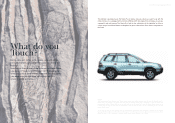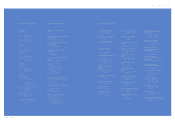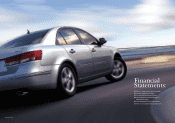Hyundai 2004 Annual Report Download - page 21
Download and view the complete annual report
Please find page 21 of the 2004 Hyundai annual report below. You can navigate through the pages in the report by either clicking on the pages listed below, or by using the keyword search tool below to find specific information within the annual report.
Hyundai Motor Company Annual Report 2004_40
Global Report
profile in the Russian market. We're both pleased and proud
because we managed to clinch this order against a field of
very tough European manufacturers. This speaks volumes
about the competitiveness of our product and paves the way
for greater penetration into the Russian market.
Australia
Hyundai increased vehicle sales to 42,510 passenger vehi-
cles in Australia in 2004, a remarkable 37.5 per cent
improvement over 2003 and one of the biggest trend turn-
arounds in the local car industry in years.
Hyundai's share of the total Australian vehicle market in
2004 rose to 4.5 per cent from 3.4 per cent in 2003. Hyundai
strengthened its grip on seventh place outright, stretching its
lead from Honda and closing in on Mazda to finish again as
the top-selling pure passenger vehicle import brand.
New Zealand
Getz was New Zealand’s best-selling car in the Micro and
Light sector through 2004.
Hungary
2004 saw Hyundai take over control of our operations in
Hungary from our independent distributor, Hyundai
Automotive Hungary. In keeping with our long-term aim to
show quality leadership across the globe we aim to imple-
ment a more customer focused strategy in Europe. We have
decided to invest US$5.3 million in setting up a sales unit in
Hungary, which will handle the sale of vehicles and car com-
ponents. We are inviting existing Hyundai dealers and newly
interested dealers to join the strengthened business opera-
tions.
Malaysia
Our operations in Malysia are still in its infancy but they are
expecting big things and are very optimistic about the future.
In 2005 Oriental-Hyundai aim to achieve a ten to 15 percent
share of Malaysia’s 1.6 litre and 1.8 litre imported passenger
car market segment. The new Elantra in Kuala Lumpur, was
recently launched there and the company believes the
Elantra will help it to reach sales of 10,000 units overall this
year. Our focus now is on increasing our service outlets as
customer service is our number one priority.
Iran
In 2004 Hyundai saw its first Iranian-made cars roll out of the
factory in September, Initially production will be between
20,000 to 30,000 units but production will ultimately increase
to 100,000 cars per year.
facturing plant with manufacturing facilities, research facili-
ties, a performance test institute, and a driving test site. As a
self-reliant facility, it has the capacity to independently
research and develop products suitable for the Indian market.
This plant will develop into our global hub for small car manu-
facturing and will serve as a strategic base for supplying small
cars worldwide.
The plant ranked in the top two in India within three years of
being opened and continues to grow rapidly by producing
quality vehicles that outrank its competitors. Of the 51,482
units sold in the first quarter of 2004, 13,738 units (primarily
the Santro) were exported to markets in the neighboring
regions as well as Europe and Mexico. Currently, the plant’s
annual production goal is 250,000 units.
In order to meet increasing auto demands in Southwest Asia,
HMI will construct a second plant, with construction to begin
in April of 2005. This plant will be built on a 2.1 million square
meter site adjacent to the existing facility at Chennai. HMI’s
goals for this plant include a production capacity of 400,000
units per annum, targeting an Indian market share of twenty
percent or more by 2007. The second plant will build the suc-
cessor to the highly successful Santro.
Hyundai Motor India Ltd. (HMI) will serve as one of our key
global manufacturing centers. The markets of the future are
the BRICs countries so in addition to serving the Indian mar-
ket, output from Chennai’s second plant will be shipped to
Europe, Latin America and neighboring markets, including
the Middle East region.
The Future of HMI
India’s fast-growing market is of great strategic importance to
Hyundai’s future. As Hyundai expands its globalization efforts
with new manufacturing investments in China, the United
States and Turkey, HMI is rapidly securing its place as an
important global manufacturing hub. Hyundai Motor India
plans on investing another US$500 million in order to expand
its capacity and become the leading auto manufacturer in the
country. HMI will secure this position by taking initiatives not
only in sales, but in terms of technology and customer satis-
faction.
Turkey
Hyundai Asan Otomotive Sanayi (HAOS), Hyundai Motor’s
joint venture plant in Turkey, was established in 1997. The
plant is equipped with a test track and has the capacity to
annually manufacture up to 60,000 units; the Verna, the
Grace, and the Starex play a major role in supplying the
European market. In 2003, HAOS greatly increased the num-
ber of units sold, from 14,505 the previous year, to 39,300.
HAOS sold over 88,262 units in 2004 and increased its mar-
ket share by over 10 percent. Currently, HAOS holds seventh
place in overall sales in Turkey. Our goal in 2005 is to clinch
the Number Five spot.
The Future of HAOS
Currently, Hyundai Motor Company owns 50 percent of the
joint venture project known as HAOS. In 2005, we plan to
increase our share of the holdings by 20 percent. This shows
our commitment to the European market, as we plan on
increasing the production capacity of our Turkish plant from
the current 60,000 units per year to 300,000. We want to
build global production systems and make Turkey the base of
our European operations.
Other World Motion
Russia
Russia’s economy is growing, and Hyundai is growing with it.
Last year, Russians bought a total of 350,000 new foreign
cars, a full 80 percent more than in 2003, spending more
money on foreign cars than on domestic cars for the first time
ever. In 2005, sales are predicted to rise by another 40 per-
cent. Hyundai Motor Company was the most popular import-
ed auto brand in Russia last year, selling a record of 50,868
cars in 2004. This is a remarkable increase in sales from pre-
vious years (14,561 in 2003 and 5,575 in 2002). We were
the first foreign automaker to sell more than 50,000 cars in
Russia in a single year.
We plan on expanding our plant capacity from the current
15,000 units to 35,000 units per year. We have also won a
bid with the Administration of the President of the Russian
Federation to supply 50 AeroExpress HSX buses. We
believe that winning this bid will really help raise Hyundai's
Production line at Hyundai Asan Otomotive Sanayi
(HAOS), our Turkish subsidiary
Hyundai is awarded Grand Prix at the Moscow
International Motor Show
Hyundai Motor Company Australia
























